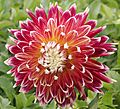Cultivar facts for kids

A cultivar is a special type of plant that people have chosen and grown. They are selected because they have certain unique features. These features, like a specific flower color, fruit size, or resistance to diseases, are passed down to their offspring. This means that when you grow a cultivar, you can be sure it will have the same traits as the parent plant.
Think of a cultivar as a specific "brand" of plant. For example, when you buy a "Granny Smith" apple tree, you expect it to grow "Granny Smith" apples, not just any apple. "Granny Smith" is a cultivar.
Contents
Naming Cultivars
Just like people have names, cultivars also have special names. These names are usually different from their scientific names (like Rosa for roses).
There is a worldwide rulebook for naming these plants. It is called the International Code of Nomenclature for Cultivated Plants (ICNCP). This system helps everyone know exactly which plant they are talking about, no matter where they are in the world. It makes sure that each cultivar has a unique name, preventing confusion among gardeners, farmers, and scientists.
Why Cultivars are Important
Cultivars are very important in many areas, from growing food to making our gardens beautiful.
For Food and Farming
Farmers rely on cultivars to grow crops that are strong and produce a lot of food. For example, different cultivars of wheat have been developed. Some might grow well in dry areas, while others resist certain plant diseases. This helps ensure we have enough food for everyone.
For Gardens and Beauty
Many of the beautiful flowers and plants you see in gardens are cultivars. Plant breeders create new cultivars to have brighter colors, interesting shapes, or longer blooming times. This allows gardeners to choose plants that fit their specific needs and tastes.
How Cultivars are Made
Cultivars are created through careful propagation and selection. This can involve:
- Selective breeding: People choose parent plants with desired traits and cross them. They then select the best offspring to become new cultivars.
- Mutations: Sometimes, a plant might naturally develop a new trait (a mutation). If this trait is useful or beautiful, people can grow more plants from it to create a new cultivar.
- Genetic engineering: In some cases, scientists use modern techniques to add specific genes to a plant. This gives the plant new traits, leading to new cultivars.
Related pages
Images for kids
-
Bread wheat, Triticum aestivum, is a type of cultivated plant. Many different cultivars have been created from it.
-
Dahlia 'Akita' is a cultivar chosen for its unique flower shape and color.
See also
 In Spanish: Cultivar para niños
In Spanish: Cultivar para niños






